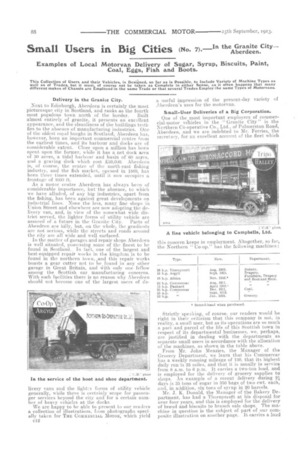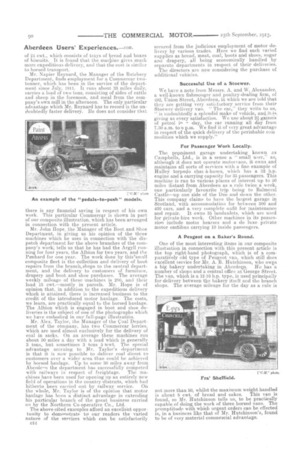Small Users in Big Cities (No. 7). In the Granite City— Aberdeen.
Page 16

Page 18

If you've noticed an error in this article please click here to report it so we can fix it.
Examples of Local Motorvan Delivery of Sugar, Syrup, Biscuits, Paint, Coal, Eggs, Fish and Boots.
This Collection of Users and their Vehicles, is Desi,ined, so far as is Possible, to Include Variety of Machine Types as well as of Trades, but it must, of course not be taken as Complete in either Sense, as it often happens that many different makes of Chassis are Employed in the same Trade or that several Trades Employ the same Types of Motorvans.
Delivery in the Granite City.
Next to Edinburgh, Aberdeen is certainly the most picturesque, city in Scotland, and ranks a,s the fourth
most populous town north of the border. Built almost entirely of granite, it presents an excellent appearance, and the cleanliness of the buildings testifies to the absence of manufacturing industries. One of the oldest royal burghs in Scotland, Aberdeen has, however, been an important commercial centre from the earliest times, and its harbour and docks are of considerable extent. Close upon a million has been spent upon the former, while it has a net dock area of 80 acres, a tidal harbour and basin of 60 acres, and a graving dock which cost £50,000: Aberdeen is, of course, the centre of the north-east fishing industry, and the fish market, opened in .1889, has been three times extended, until it now occupies a frontage of 1000 ft.
As a motor centre Aberdeen has always been of considerable importance, but' the absence, to which we have alluded, of any big industries, apart from the fishing, has been against great developments on industrial lines. None the less, many fine shops •in Union Street and elsewhere are now adopting the delivery van, and, in view of the somewhat wide district served, the lighter forms of utility vehicle are assured of a future in the Granite City. Parts of Abe,edeen are hilly, but, on the whole, the gradients are not serious, while the streets and roads around the city are all wide and well surfaced.
In the matter of garages and repair shops Aberdeen is well situated, possessing some of the finest to be found in Scotland. In fact, one of the largest and best-equipped repair works in the kingdom.is to be found in the northern town, and this repair works boasts a gear cutter not to be found in any other garage in Great Britain, and Ikith only one fellow among the Scottish car manufacturing concerns. With such facilities there is no reason why Aberdeen should not become one of the largest users of do
livery vans and the lighter forms of utility vehicle generally, while there is certainly scope for passenger services beyond the city and for a certain number of heavy vehicles at the docks.
We are happy to be able to present to our readers a collection of illustrations, feom photographs specially taken for THE COMMERCIAL MOTOR, which yield c12 a useful impression of the present-day variety of Aberdeen's uses for the motorvan.
Small-User Deliveries of a Big Corporation.
One of the, most important. employers of commercial-motor vehicles in the " Granite, City " is the Northern CO-operative Co., Ltd., of Palmerston Road, Aberdeen, and we are indebted to Mr. Ferries, the secretary, for an excellent account of the fleet which
this concern keeps in employment. Altogether, so far, the Northern " Co-op." has the fcllowing machines: Strictly speaking, of course, our readers would be right in their criticism that tins company is not, in reality, a small user, but as its operations are so much a part and parcel of the life of this Scottish town in respect of its departmental businesses, we. perhaps, are justified in dealing with the departments as separate small users in accordance with the allocation of the machines, as shown in the table above.
From Mr. John Menzies, the Manager . of the Grocery Department, we learn that his Commerea,r has a weekly running mileage of 130, that its highest daily run is 35 miles, and that it is usually in service from 8 a.m. to 6 p.m. It carries a two-ton load, and is employed for the delivery of grocery supplies to shops. An example of a recent delivery during VI days is 35 tons of sugar in 350 bags ef two cwt.. each, and, in addition, six tons of syrup in 20 barrels. Mr. J. K. Donald, the Manager of the tiakery Department, has had .a Thornyeroft at his disposal for over four years, and this is employed for the delivery of bread and biscuits to branch sale shops. The machine in question is the subject of part of our composite illustration on another page. It carries a load
of 24 cwt., which consists of trays of bread aud boxes of biscuits. It is found that the maebine gives much more expeditious delivery, and that the cost is similar to horsed transport.
-Mr. Napier Reynard, the Manager of the Butchery Department, finds employment for a Comme.rcar twotonner, which has been in the service of the department since July, 1911. It runs about :33 miles daily, carries a load of two tons, consisting of sides of cattle and sheep in the forenoon, and meal from the company's own mill in the afternoon. The only particular advantage which Mr. Reynard has to record is the undoubtedly faster delivery. Ile does not consider that there is any financial saving in respect of his own work. This particular Counnercar is shown in part of our composite illustration, which has been arranged in connection with the present article.
Mr. John Hope, the Manager of the Boot and Shoe Department, in giving us his opinion of the three machines which he uses in connection with the dispatch department for the above branches of the company's work; tells us that he has had the Argyll running for four years, the Albion for two years. and the Panhard for one year. The work done by thiesmall composite fleet is the .colleCtion and delivery of boot repairs from the branch, shops to the c.entral department, and the delivery to customers of furniture, drapery and boot and shoe purchases. The average weekly mileage of these -machines is 280, and their load 15 cwt.—mostly in parcels. Mr. Hope is of opinion that, in addition to the expeditious delivery which is attained, there is increased business to the credit of the introduced motor haulage. The costs, we learn, are practically equal to the horsed haulage. The _Albion which is engaged in boot and shoe deliveries is the subject of one of the photographs which we have embodied in our full-page ilinstratinn.
Mr. Alex. Taylor, the Manager of the coal Department of the company, has two Commercar lorries, which are used almost exclusively for the delivery of coal in sacks. On an average these machines .run about 50 miles a day with a. load which is generally 3 tons, but sometimes 3 tons 5 9cwt. The special advantage accruing to Mr. Taylor's department is that it is now possible to deliver coal direct to customers over .a wider area than could be achieved by horsed haulage. Up to some 30 miles away from Aberdeen the department has successfully competed with railways in respect of freightage. The machines have been used for opening up an entirely new field of operations in the country districts, which had
hitherto been carried out by railway service_ On the whole, Mr. Taylor is of the opinion that motor haulage has been a distinct advantage in extending his particular branch. of the great business carried on by the Northern Co-operative Co., Ltd. The above-cited examples afford an excellent opportunity to demonstrate tol our readers the varied nature of the services which can be satisfactorily el4
secured from the judicious employment of motor delivery by various trades. Here we find such varied supplies as bread, meat, coal, loots and shoes, sugar and drapery, all being economically handled by separate departments in respect of their deliveries.
The directors arc now considering the purchase of additional vehicles.
Successful Use of a Stoewer.
We have a note from Messrs. A. and W. Alexander, a well-known fishmonger and poultry-dealing firm, of 402, Union Street, Aberdeen, in which we are told that they are getting very satisfactory service from their Stoewer delivery van. " The car," they write to us, "is undoubtedly a splendid make of vehicle, and.it,i.,4, giving us every satisfaction. We use about 241 gallons of petrol in day, the ear running all day from 7.30 a.m. to o p.m. We find it of very great advantage in respect of the quick delivery of the perishable corn moditres which we supply."
For Passenger Work Locally.
The prominent garage undertaking known as Campbells, Ltd., is in a sense a " small user,' as, although it does not operate inotorvans, it owns and maintains all sorts of services with a fine example of Halley torpedo chai-k-bancs, which has a 32 h.p. engine and a carrying capacity for 35 passengers. This machine is run to various places of interest up to 50 miles distant from Aberdeen as a rule twice a week, one particularly favourite trip being to Balmoral Castle—up one side of the Dee and down the other. This company claims to have the largest garage in Scotland, with accommodation for between 300 and 400 cars, and a very complete oufit for maintenance and repair. It owns 35 landaulets, which are used for private-hire work. Other machines in its possession include motor hearses and a de luxe private motor omilibus carrying 10 inside passengers.
A Peugeot on a Baker's Round.
One of the most interesting items in our composite illustiLation in connection with this present article is the top right-hand photograph, which is of a comparatively old type of Peugeot van, which still does excellent service for Mr. A. B. Hutchinson, who owes a big bakery undertaking in AberdNn. He has a number of shops and a central office at George Street. The van, which is a 12-16 h.p. type, is used principally for delivery between the bakery itself and the branch shops. The average mileage for the day as a rule is
not more than 50, whilst the maximum weight handled is about 8 cwt. of bread and cakes. This van is found, so Mr. Hutchinson tells us, to be practically capable ,r'yf doing the work of three horsed vans. The promptitude with which urgent orders can be effected is, in a business like that of Mr. Hutchinson's, found to be of very material commercial advantage.
























